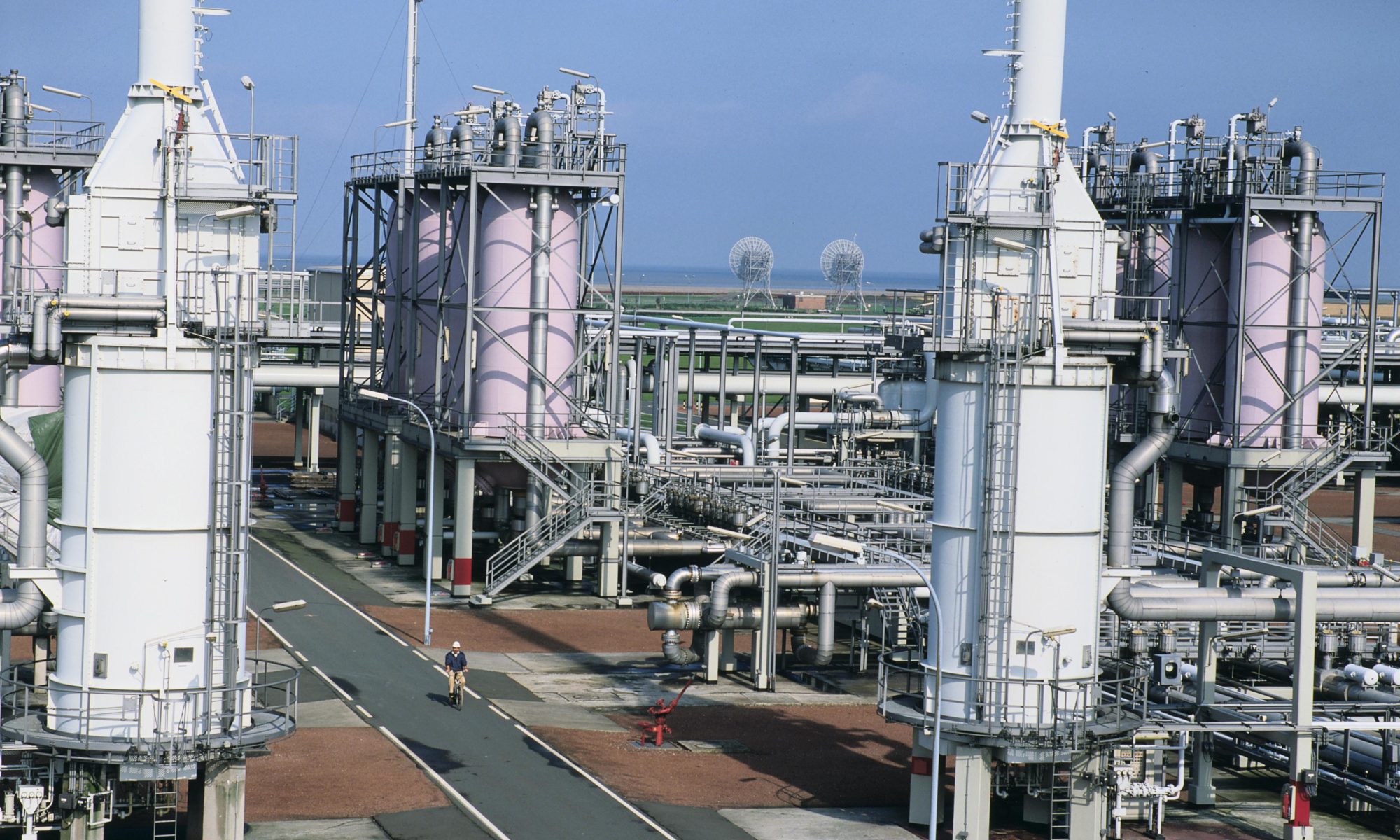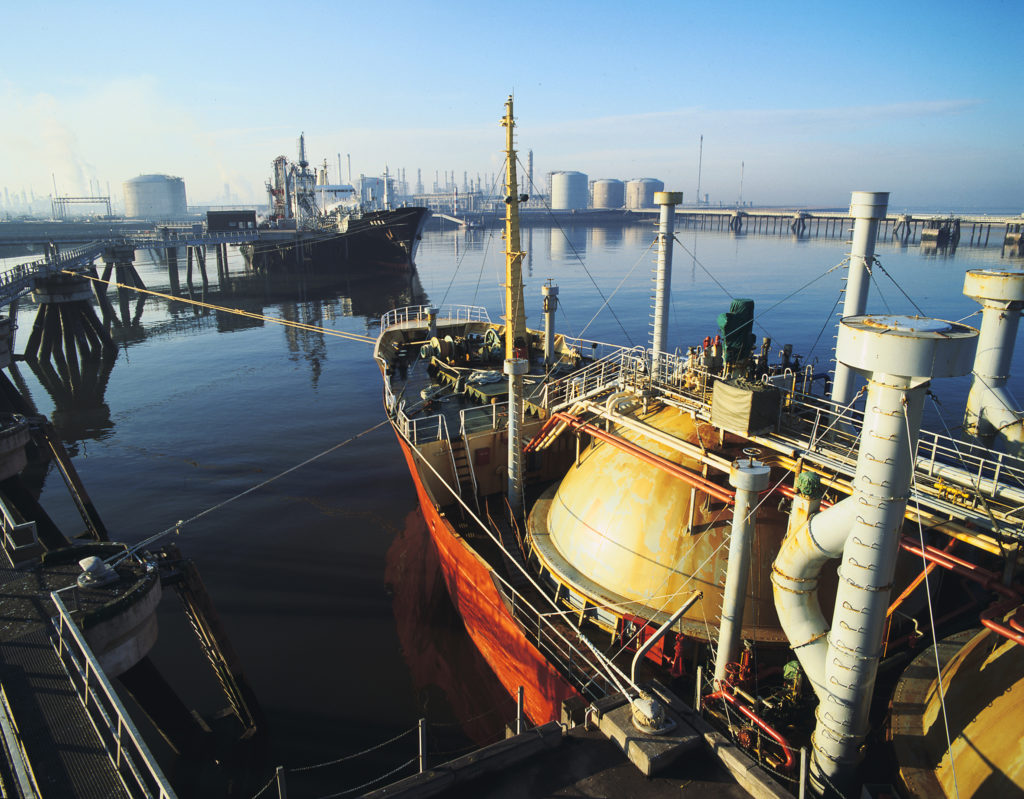The oil and gas terminals

Oil terminal in Teesside

The terminal at Teesside in north-east England receives oil and natural gas liquids (NGL) by pipeline from the Ekofisk field. It comprises stabilisation, NGL fractionation, storage tanks for crude oil and an export port.
After arriving through the Norpipe Oil line, crude and NGL are separated and the oil goes through a stabilisation process before reaching the 10 storage tanks, which each hold 750 000 barrels.
The NGLs go to the fractionation facility, with a daily capacity of 64 000 barrels, for separation into methane, ethane, propane, and normal and iso butane.
While the methane (natural gas) is used to fuel the plant, the other products (now known as liquefied petroleum gases – LPG) are made liquid by cooling and stored for export by sea.
One reason for the choice of Teesside as the landfall for the Ekofisk pipeline was the opportunity it offered to install deepwater quays.
The terminal has four of these, with those for crude oil able to handle tankers up to 150 000 deadweight tonnes. The LPG quays can accept carriers loading as much as 60 000 cubic metres.
Two of the crude oil quays lie on the main channel of the River Tees, while the others have been installed in dredged docks.
Gas terminal in Emden

Gas arriving at the Emden terminal from the Ekofisk Complex enters nine parallel treatment trains for cleaning, metering and onward distribution to the buyers.
The North Sea gas is very clean, and needs only limited treatment to remove small amounts of sulphur compounds using an absorption process. Impure molecules from the gas accumulate on the surface of small particles, which act as filter spheres.
Each of the nine trains comprises four process columns and a process oven. The gas enters the top of a column and leaves through the base after passing through the filter spheres.
That leaves the gas ready for sale, and it is piped to the fiscal metering station before entering the buyer receiving pipelines and distribution network.
Three separate commercial pipeline systems connect to the terminal, operated by Ruhrgas, BEB and Gastransport Services (previously Gasunie) respectively. They pipe the gas away on behalf of the gas buyers.
The Norsea Gas Terminal in Emden was officially opened in September 1977 by Norwegian industry minister Bjartmar Gjerde and Phillips executive Gordon Goerin.
Ranking as the first gas sales deal for the Norwegian continental shelf, the Ekofisk agreement paved the way for later contracts covering other fields off Norway.
Regularity at the Emden terminal has been very high, with its own equipment never causing shutdowns. Maintenance takes place when other parts of the system are off line.
The terminal has a daily capacity of about 2.1 million cubic feet of gas per day.
Gas transport restructured
Norpipe AS owned the gas pipeline from Ekofisk to Emden until the transport system for the Norwegian offshore sector was restructured at 1 January 2003.
Norsea Gas A/S furthermore served as the formal owner of the Emden facility, with Phillips Petroleum and then ConocoPhillips as operator for both pipeline and terminal.

Since 2007, Norway’s state-owned Gassco company has been responsible for technical operation of the facilities on behalf of their owners.
That included operator responsibility for the H7 and B11 booster platforms along the gas pipeline, which were shut down in 2007 and 2013 respectively and have since been removed.
The Gassled partnership is a project collaboration embracing 10 companies which collective own large parts of the gas infrastructure on the Norwegian continental shelf (NCS).
A substantial proportion of Norway’s gas deliveries to Germany continues to arrive at the Emden terminal, including the volumes piped from Ekofisk.
Preliminary planning for a new terminal in the German port began in 2011, with Gassled taking the investment decision for this development in the autumn of 2012.
Construction work began in the following year, with the new facility being built on an unused part of the existing terminal site.
The new terminal has not expanded export capacity. But its functionality is well adapted to future processing needs for fields in the Greater Ekofisk Area and other parts of the NCS sending gas through the Norpipe system.
It was officially opened on 24 May 2016 by Elisabeth Aspaker, the Norwegian government minister for the EU and the European Economic Area. That closed a chapter in Ekofisk’s history.
Source: ConocoPhillips Norge

When some one searches for his necessary thing, therefore he/she wants to be available that in detail, thus
that thing is maintained over here.
Great article! We will be linking to this particularly great post on our
website. Keep up the great writing.
I am actually grateful to the owner of this
site who has shared this enormous paragraph at at this place.
Howdy just wanted to give you a quick heads up. The words in your post seem to be running off the screen in Ie.
I’m not sure if this is a format issue or something to do with web browser
compatibility but I thought I’d post to let you know. The style
and design look great though! Hope you get the issue resolved soon. Kudos
Howdy! I just wish to give you a big thumbs up for your excellent info you have here
on this post. I will be coming back to your blog for more soon.
I’m really impressed along with your writing talents and also with the layout on your weblog.
Is that this a paid subject matter or did you modify it your self?
Anyway keep up the nice high quality writing,
it’s uncommon to see a great blog like this one these days..